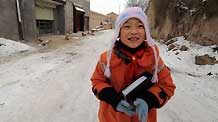Economic, Climate, Population Shifts Threaten Child Rights Development
Adjust font size:
Changes in economy, climate and population are threats to recent advances in child rights, said a report released Friday by the United Nations Children's Fund (UNICEF) and Xinhua News Agency.
"Strains on household, corporate and government budgets are threatening spending on services and commodities essential to meeting children’s rights to survival, development, protection and participation," stated the report, a special edition of the UNICEF's series on "The State of the World' s Children."
The launch of the report marked the Universal Children's Day and the 20th anniversary of the adoption of the Convention on the Rights of the Child (CRC) on Nov. 20, 1989.
It was also part of Friday's Global News Day for Children aiming at raising public awareness on children's living environments and their development.
The report showed that in 2009, the steep rise in unemployment and the precipitous fall in world output, trade and investment, together with influences of the sharp spikes in food and fuel prices of 2008, led to risks to children's education, nutritional status and health care, particularly among the least developed countries and the poorest and most vulnerable communities and social groups in all nations.
However, challenges for child rights came not only from the economic sphere, according to the report. "They might also face an increasingly inhospitable natural environment."
Damage to the environment might threaten such hard-won advances as improved drinking water, greater food security, lower under-nutrition among under-fives and stronger disease control in many developing countries, it showed.
"Children are particularly vulnerable to the impact of climate change," stated the report. Many of the main killers of young children, such as under-nutrition, acute respiratory infections, diarrhea, malaria and other vector-borne diseases, are known to be highly sensitive to climatic conditions.
Besides, children’s stage of physiological and cognitive development, the growing correlation between civil strife and climatic change, and the relative incapability of the world’s least developed countries with large child populations to bear the impact of climate change were also considered reasons for the climate threat to child rights.
The report pointed out, by 2030, about 40 years after the convention's entry into force, one quarter of the world’s under-fives will live in the 49 countries currently considered as least developed.
Therefore, without far greater efforts to reach children in the most marginalized and impoverished areas, the risk is high that this quartile of the world's youngest citizens will face even greater relative disparities in access to health care, education and protection than faced by their current counterparts in the poorest nations.
Only through collaborative, integrated approaches, the convention's promises for all children could be met, said the report.
As for unknotting those threats, the report proposed to make children's best interests the primary test of governance, develop capacities to realize the rights of children and support social and cultural values that respect the rights of children.
"If we truly believe that the world owes its children the best it has to give, we can do no less," the report said.
(Xinhua News Agency November 20, 2009)





